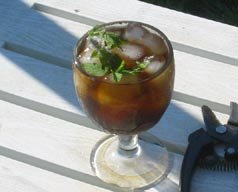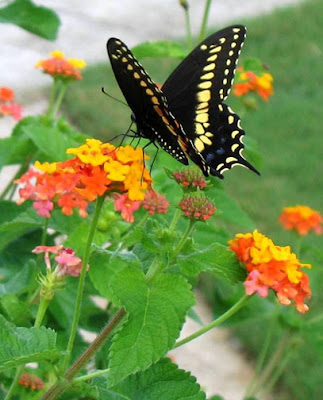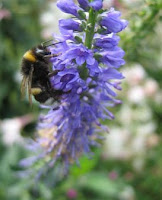June 21, 2006:
Today is the first day of summer; with humidity level at 67% and predictions of 91 degrees F., it definitely feels like summertime. The hot, muggy days deplete my scant store of energy more than the activity of gardening. I would consider that a sign of my age, but a fatigued young helper said, "The work isn't that hard, it's the heat!" So, maybe it isn't my age after all... I tell myself.
June 26, 2006:
Here I am, about to perish from the heat when I read that on Monday, June 12, New Zealand had about a foot of snow the heaviest and wettest in 50 years. New Zealand spawns serious gardeners. They are having a tough go of it now with broken trees, shrubs, and broken just about everything. I have deep empathy for them. The last big one they had was in June 2003. That was the year we had our extremely damaging ice storm in February - then they caught the weather in June. Wild Weather!
July 1, 2006:
My attention deficit problem is acting up today - thoughts and ideas splattered all about, can't get into the groove. Must be the heat. Will pull myself together here and get at it. Much needs to be done with the weeding!
Reminds me of the sign one gardener had in her potting shed that read something like this:
"Gardening is doing:
what should be done,
when it should be done,
the way it should be done,
whether you feel like it or not."
She's exactly right. And, I wish I could remember what magazine I saw that in so I could give her credit here.


Maybe a glass of nice strong iced tea will set me right.
July 2, 2006:
Today I discovered the Fahrenheit and Celsius conversion formula by which I can translate today's punishingly hot 95 degrees F. heat to approximately 35 degrees C. Whew! That sounds much better.
(I found the information here: http://vathena.arc.nasa.gov/curric/weather/fahrcels.html)
Wish I could bundle up some of it, and send it to gardeners in the Southern hemisphere who are worrying about the possibility of frost tonight. I do have difficulty getting used to the concept of their winter in July and August, and preparing for December holidays, such as Christmas, by mowing their verdant lawns.

Eastern Black Swallowtail on Lantana
July 3, 2006: Parsley in the whiskey barrel.
I like to start parsley from seed in order to have a large number of plants. Then I set them everywhere in all the beds for the baby Black Swallowtail butterflies. The females lay their eggs on plants of the carrot family which includes parsley. Also, I like to have some up close so I can watch the babies' development... thus the ones in the half-barrel.
At first, they look like tiny bird droppings, then morph to look like larger bird droppings; that is nature's way to protect them from the bird predators who might eat them. Before long, they are lovely, slick, and colorful black, white, yellow and/or green larvae. We usually call them caterpillars. If disturbed or provoked, as in being tickled with a blade of grass, they will show their beautiful orange antenna that emits an odor that surely sends the message: 'I'm not good to eat!'

The following photo shows two different stages of larvae. In the lower left-hand corner can be seen one younger than the large one on the right. The younger one does resemble a bird dropping, but at first they are much smaller than this one.

The Above Photo:
Black swallowtail larvae (Papilio polyxenes)
Used with permission from:
Hannah Nendick-MasonCopyright © 2004

Above: Notice its little feet.
The larvae are little feeding machines, munching and munching away, so soon they are plump little things that remind me of our four babies when they wore pajamas that had feet. These fat little butterfly babies eat for days and then go off to make their cocoon.
The first time I cultivated some where they could be watched, I thought they were falling out of the large planter, so I kept putting them back in. Then they would "fall out" again. I finally realized they were through entertaining me, and were trying to go find a good place to attach to, where they would make their cocoons. They were ready to move on with their lives so they could become beautiful, graceful flying creatures.
This summer I have watched them eat the parsley totally up leaving nothing but a ring of little short stubs of stems.
Now the parsley is growing back again! Hmmm... Second crop of parsley? Second crop of babies? Will have to wait and see.

Addendum 2008:
Parsley grew, but there were no more babies in the whiskey barrel.

July 4, 2006:
A few years ago when an old black locust tree that stood in the back yard fell, I planted a small butterfly and hummingbird garden around the stump.
Several things including four Butterfly shrubs (Buddleia davidii) were planted on top of the many spring bulbs in the soil. The shrubs were planted approximately north, south, east, and west around the stump. There were one each of white, pink, lavender, and dark purple.
When I bought them, the woman assisting me said the dark ones are not as hardy and do not survive the winter as well. I wanted to try anyway. But she was right, the dark one did not come back the next spring. The others have done well. This year I noticed of the three, the pink butterfly bush bloomed first. Could that be because it is on the south side of the round bed? That would be my guess.
July 21,2006:
Humidity hangs thick and heavy. When I step outside it feels as if we could cut it with a knife. Even the birds are quiet... means storms are brewing.
July 22,'06:
Yesterday it stormed at six o'clock p.m., then in 30 minutes the electricity went off for ten hours. Rough weather.






















































